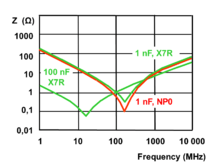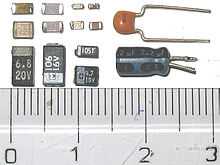Decoupling capacitor


A decoupling capacitor is a capacitor used to decouple one part of an electrical network (circuit) from another. Noise caused by other circuit elements is shunted through the capacitor, reducing the effect it has on the rest of the circuit. An alternative name is bypass capacitor as it is used to bypass the power supply or other high impedance component of a circuit.
Discussion
For example, if the voltage level for a device is fixed, changing power demands are manifested as changing current demand. The power supply must accommodate these variations in current draw with as little change as possible in the power supply voltage. When the current draw in a device changes, the power supply cannot respond to that change instantaneously. As a consequence, the voltage at the device changes for a brief period before the power supply responds. The voltage regulator adjusts the amount of current it is supplying to keep the output voltage constant but can only effectively maintain the output voltage for events at frequencies from DC to a few hundred kHz, depending on the regulator (some are effective at regulating in the low MHz). For transient events that occur at frequencies above this range, there is a time lag before the voltage regulator responds to the new current demand level. This is where the decoupling capacitor comes in. The decoupling capacitor works as the device’s local energy storage. The capacitor cannot provide DC power because it stores only a small amount of energy but this energy can respond very quickly to changing current demands. The capacitors effectively maintain power-supply voltage at frequencies from hundreds of kHz to hundreds of MHz (in the milliseconds to nanoseconds range). Decoupling capacitors are not useful for events occurring above or below this range.
Decoupling
One common kind of decoupling is of a powered circuit from signals in the power supply. Sometimes, for various reasons, a power supply supplies an AC signal superimposed on the DC power line. Such a signal is often undesirable in the powered circuit. A decoupling capacitor can prevent the powered circuit from seeing that signal, thus decoupling it from that aspect of the power supply circuit.
Another kind of decoupling is stopping a portion of a circuit from being affected by switching that occurs in another portion of the circuit. Switching in subcircuit A may cause fluctuations in the power supply or other electrical lines, but you do not want subcircuit B, which has nothing to do with that switching, to be affected. A decoupling capacitor can decouple subcircuits A and B so that B doesn't see any effects of the switching.
To decouple a subcircuit from AC signals or voltage spikes on a power supply or other line, a bypass capacitor is often used. A bypass capacitor is to shunt energy from those signals or transients past the subcircuit to be decoupled, right to the return path. For a power supply line, a bypass capacitor from the supply voltage line to the power supply return (neutral) would be used.
High frequencies and transient currents flow through a capacitor, in this case in preference to the harder path through the decoupled circuit, but DC cannot go through the capacitor, so continues on to the decoupled circuit.
Switching subcircuits
In a switching subcircuit switching noise must be suppressed. When a load is applied to a voltage source, it draws a certain amount of current. Typical power supply lines show inherent inductance, which results in a slower response to change in current. This in turn affects the transient voltage levels, since if the load current is zero the voltage across the load is zero as well. This sudden voltage drop would be seen by other loads as well if the inductance between two loads is much lower compared to the inductance between the loads and the output capacitors of the power supply. This is only temporary; the inductor ultimately saturates (that is the magnetic field around the conductor reaches its max), the voltage drop across the inductor reaches zero, and the supply voltage comes back to normal. But even a temporary reduction in voltage can disturb adjacent subcircuits. Decoupling caps provide instantenous current jolt which helps maintain constant voltage across a subcircuit (or provide a low impedance path for the transient currents; different descriptions are used by different industries).
To decouple other subcircuits from the effect of the sudden current demand, a decoupling capacitor can be placed between the supply voltage line and its reference (ground) next to the switched load. While the load is switched out, the capacitor charges up to full power supply voltage and otherwise does nothing. When the load is applied, the capacitor initially supplies demanded current. Ideally, by the time the capacitor runs out of charge, the power supply line inductance is saturated, and the load can draw full current at normal voltage from the power supply (and the capacitor can recharge too). Note that the voltage dip is reduced but not eliminated; i.e., the decoupling is not perfect and sometimes parallel combinations of caps are used to improve response. The best way to reduce switching noise is to design a PCB as a giant capacitor by sandwiching the power and ground planes across a dielectric material.
The size of the capacitor must be reasonable, and there is a tradeoff between capacitor size and signal quality at a given frequency. If a cap is too large it would distort the signal by charging too slowly and filtering out the signal's most needed high-frequency components.
Transient load decoupling
Transient load decoupling as described above is needed when there is a large load that gets switched quickly. The parasitic inductance in every (decoupling) capacitor may limit the suitable capacity and influence appropriate type if switching occurs very fast.
Logic circuits tend to do sudden switching (an ideal logic circuit would switch from low voltage to high voltage instantaneously, with no middle voltage ever observable). So logic circuit boards often have a decoupling capacitor close to each logic IC connected from each power supply connection to a nearby ground. These capacitors decouple every IC from every other IC in terms of supply voltage dips.
These capacitors are often placed at each power source as well as at each analog component in order to ensure that the supplies are as steady as possible. Otherwise, an analog component with poor power supply rejection ratio (PSRR) will copy fluctuations in the power supply onto its output.
In these applications, the decoupling capacitors are often called bypass capacitors to indicate that they provide an alternate path for high-frequency signals that would otherwise cause the normally steady supplies to move. Those components that require quick injections of current can bypass the power supply by receiving the current from the nearby capacitor. Hence, the slower power supply connection is used to charge these capacitors, and the capacitors actually provide the large quantities of high-availability current.
Placement
A transient load decoupling capacitor should usually be placed as close as possible to the device requiring the decoupled signal. The goal is to minimize the amount of line inductance and series resistance between the decoupling capacitor and that device, and the longer the conductor between the capacitor and the device, the more inductance there is.[1]
The guidelines for placing a high-speed decoupling capacitor on a multi-layer printed circuit board depend on whether the board has dedicated power distribution planes and how closely spaced those planes are.[2]
Since capacitors differ in their high-frequency characteristics (and capacitors with good high-frequency properties are often types with small capacity, while large capacitors usually have worse high-frequency response), decoupling often involves the use of a combination of capacitors. For example in logic circuits, a common arrangement is ~100 nF ceramic per logic IC (multiple ones for complex ICs), combined with electrolytic or tantalum capacitor(s) up to a few hundred μF per board / board section.
References
- ↑ Capacitor Design Data, and Decoupling Placement, How-to on Leroy's Engineering Web Site
- ↑ LearnEMC Circuit Board Decoupling Information
External links
- Bypass Capacitors – a large collection of articles by Howard Johnson relating to bypassing/decoupling
- ESR and Bypass Capacitor Self Resonant Behavior: How to Select Bypass Caps – article written by Douglas Brooks
- Decoupling – decoupling guide for various frequencies by Henry W. Ott
- Bypass Capacitors, an Interview With Todd Hubing – by Douglas Brooks, President, UltraCAD Design, Inc.
- Choosing and Using Bypass Capacitors – application note from Intersil
- Power Supply Noise Reduction – how to design effective supply bypassing and decoupling networks by Ken Kundert
- Circuit Board Decoupling Information – decoupling guidelines for various types of circuit boards
- Embedded Capacitance in a PCB for decoupling – Designing in hidden capacitance in the printed circuit board